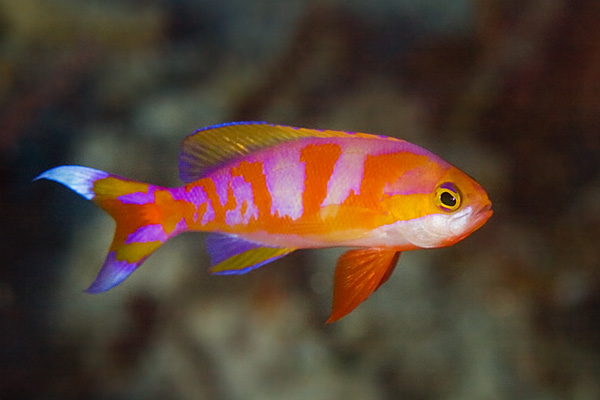Pseudanthias calloura is widely known for its rarity as well as its beauty. It’s scarcity in the trade has promoted this species to the top of many wish lists, only to bring disappointment to said list makers. Commonly known as the Aurora anthias, P. calloura is always rare and has only appeared a handful of times in the Japanese market, before disappearing from the scene altogether. The male above displaying nuptial colours by Yusuke Yoshimo is reason enough for many to lose sleep over.

Beautiful photos of Pseudanthias calloura showing incredible lavender-blue stripes on a cadmium orange body have plagued the internet, but photos showing normal coloured males are scarce. That is because it is only when the males display their nuptial coloration for courtship that they turn on that amazing lilac hue; and likewise pique the interest of underwater photographers. The photo above from Umioniyome dive blog shows a regular unexcited male Aurora anthias swimming along side Pseudanthias smithvanizi and Chaetodon burgessi. In its unexcited form, the barring on the males take on a similar shade of cadmium as the body.

The photograph above shows another male in its normal coloration, swimming in Palau. Judging from the environment as well as fishes present in these pictures, it is clear that P. calloura is not a species fond of shallow reef crests. The Aurora anthias is commonly seen at depths exceeding 150 ft, and for a long time has only been known to swim in the waters of Palau. The scarcity of P. calloura in the trade ties closely with the availability of fishes coming out from Palau collectors. In recent years, there have been no reliable export of fishes from Palau, sans a few sparse private collections made for japanese aquarists. Together with Cirrhilabrus earlei and Liopropoma tonstrinum, the japanese were the only ones who enjoyed the offerings of Pseudanthias calloura from Palau. But even these shipments were very rare and far between.

You may have remembered, in 2012 we posted about Pseudanthias calloura being photographed and documented in Celebes, Indonesia. P. calloura was first documented in 1996, and then officially described in 2001 with specimens obtained and seen from Palau. The trio of Aurora anthias above was photographed in the Celebes in 1998, and it may be possible that the information regarding the range extension of this species was not available at the time of description. The fact that Pseudanthias calloura exists in Indonesia would mean that it was to be only a matter of time before collectors started stumbling upon, and offering it to the aquarium trade. However that never happened for as long as P. calloura was heard or known, and all specimens however few, came only from Palau.

In the past week or so however, a few cell phone pictures of the highly coveted Aurora anthias reportedly caught by Indonesian divers started circulating around the internet. No one really knew if the pictures were real, and admittedly even I was quite skeptical. Whether or not these would turn out to be the first Indonesian collected Aurora anthias was unknown at that time, until now.

As suddenly as the news emerged, we’re seeing numerous specimens popping up here and there globally. Dejong Marine in Europe posted two photos of their Aurora haul, featuring mostly beautiful males. We’ve also seen them appearing at the same time in Hong Kong, as well at Iwarna Aquafarm of Singapore. We obtained two females to try, as well as to photograph, and are happy to report that this species is generally quite hardy for a deepwater Pseudanthias.
We expected this deepwater species to be poorly collected, especially since they were coming from Indonesian sources. However sans a few normal shipping casualties, the remaining specimens proved to be quite hardy and took frozen food very readily. Like most Pseudanthias, the larger males are more sensitive and don’t do as well. We experienced the same, and it is the females that show better resilience and adaptability. The Aurora anthias is a larger and more robust Pseudanthias species, measuring in at around 4 inches. As such they seem to be less picky and are able to handle larger chunkier food offerings.
Unlike the smaller shallow water species, P. calloura does not form big aggregations and are often seen in smaller lose groups. An odd number like three is best, if you intend to include a male. Alternatively, since all Pseudanthias are hermaphroditic, a quartet of females may work and one would eventually change to a male. It is likely that more specimens will appear now that the Indonesians are collecting it. However do not expect a decrease in price compared to the Palau counterparts. These fishes are still expensive and costs at least a couple hundred each.



